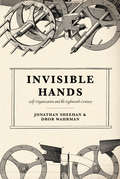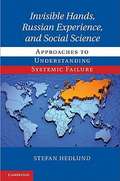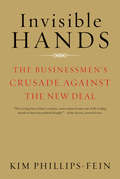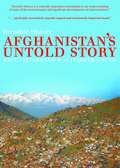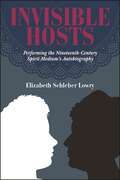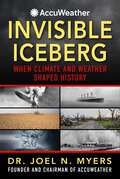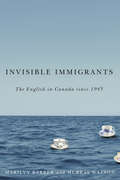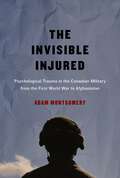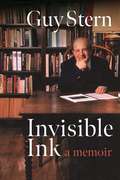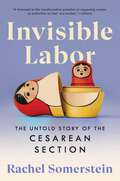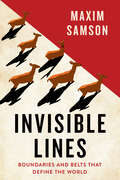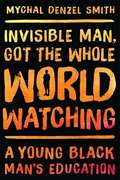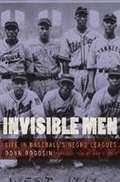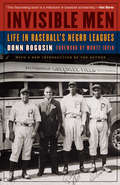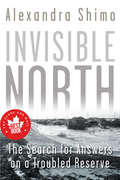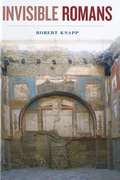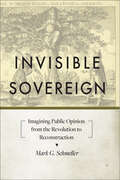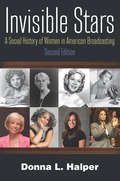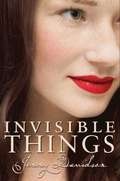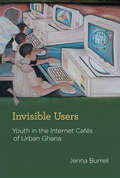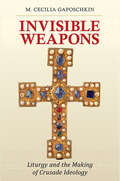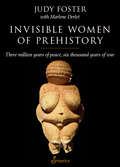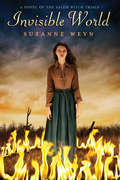- Table View
- List View
Invisible Hands
by Jonathan Sheehan Dror WahrmanWhy is the world orderly, and how does this order come to be? Human beings inhabit a multitude of apparently ordered systems--natural, social, political, economic, cognitive, and others--whose origins and purposes are often obscure. In the eighteenth century, older certainties about such orders, rooted in either divine providence or the mechanical operations of nature, began to fall away. In their place arose a new appreciation for the complexity of things, a new recognition of the world's disorder and randomness, new doubts about simple relations of cause and effect--but with them also a new ability to imagine the world's orders, whether natural or manmade, as self-organizing. If large systems are left to their own devices, eighteenth-century Europeans increasingly came to believe, order will emerge on its own without any need for external design or direction. In Invisible Hands, Jonathan Sheehan and Dror Wahrman trace the many appearances of the language of self-organization in the eighteenth-century West. Across an array of domains, including religion, society, philosophy, science, politics, economy, and law, they show how and why this way of thinking came into the public view, then grew in prominence and arrived at the threshold of the nineteenth century in versatile, multifarious, and often surprising forms. Offering a new synthesis of intellectual and cultural developments, Invisible Hands is a landmark contribution to the history of the Enlightenment and eighteenth-century culture.
Invisible Hands, Russian Experience, and Social Science
by Stefan HedlundThis book investigates cases in which national and international activities have gone massively wrong, entailing seriously negative consequences, and in which the sophisticated analytical models of social science have ceased to be helpful. Illustrations range from the global financial crisis to the failure to achieve speedy systemic change in the former Soviet Union and the failure to achieve development in the Third World. The analysis uses as a backdrop long-term Russian history and short-term Russian encounters with unrestrained capitalism to develop a framework that is based in the so-called new institutionalism. Understanding the causes of systemic failure is shown to require an approach that spans across the increasingly specialized subdisciplines of modern social science. Demonstrating that increasing theoretical sophistication has been bought at the price of a loss of perspective and the need for sensitivity to the role of cultural and historical specificity, the book pleads the case for a new departure in seeking to model the motives for human action.
Invisible Hands: The Businessmen's Crusade Against the New Deal (Playaway Adult Nonfiction Ser.)
by Kim Phillips-Fein"A compelling and readable story of resistance to the new economic order."--Boston Globe Invisible Hands tells the story of how a small group of American businessmen succeeded in building a political movement. Long before the "culture wars" of the 1960s sparked the Republican backlash against cultural liberalism, these high-powered individuals actively resisted New Deal economics and sought to educate and organize their peers. Kim Phillips-Fein recounts the little-known efforts of men such as W. C. Mullendore, Leonard Read, and Jasper Crane, drawing on meticulous research and narrative gifts to craft a compelling history of the role of big and small business in American politics--and a blueprint for anyone who wants insight into the way that money has been used to create political change. Some images in the ebook are not displayed owing to permissions issues.
Invisible History: Afghanistan's Untold Story
by Paul Fitzgerald Elizabeth GouldFitzgerald and Gould (journalists who have been reporting on Afghanistan and US policy towards Afghanistan since 1981) narrate the political history of Afghanistan and provide a critical analysis of US policy towards Afghanistan. They reveal the manipulations of Afghanistan by the United States and other great powers from the "Great Game" of the 19th century through the current "War on Terror" and describe its terrible consequences for the Afghan people. Annotation ©2009 Book News, Inc. , Portland, OR (booknews. com)
Invisible Hosts: Performing the Nineteenth-Century Spirit Medium's Autobiography
by Elizabeth Schleber LowryFinalist for the 2017 Foreword INDIES Book of the Year Award in the Religion categoryInvisible Hosts explores how the central tenets of Spiritualism influenced ways in which women conceived of their bodies and their civic responsibilities, arguing that Spiritualist ideologies helped to lay the foundation for the social and political advances made by women in the late nineteenth and early twentieth centuries. As public figures, female spirit mediums of the Victorian era were often accused of unfeminine (and therefore transgressive) behavior. A rhetorical analysis of nineteenth-century spirit mediums' autobiographies reveals how these women convinced readers of their authenticity both as respectable women and as psychics. The author argues that these women's autobiographies reflect an attempt to emulate feminine virtues even as their interpretation and performance of these virtues helped to transform prevailing gender stereotypes. She demonstrates that the social performance central to the production of women's autobiography is uniquely complicated by Spiritualist ideology. Such complications reveal new information about how women represented themselves, gained agency, and renegotiated nineteenth-century gender roles.
Invisible Iceberg: When Climate and Weather Shaped History
by Dr. Joel N. MyersDiscover the impactful ways that climate and weather changed the very course of human history from the founder and CEO of AccuWeather! Join AccuWeather founder and CEO Dr. Joel N. Myers on a journey from the beginning of time to the modern day to see how weather and climate impacted world events throughout history, both the good and the bad. Learn about the comet that hit Earth almost 67 million years ago, and how it triggered a massive climate disruption that led to the extinction of the dinosaur; the dramatic climate shift in 1213 BC that created the conditions for the Ten Plagues of Egypt, a foundational moment in three major world religions; how superior knowledge of the winds allowed the ancient Greeks to prevail over Persian attackers in 400 BC; the volcano in 44 BC that helped launch the Roman Empire; how Tropical storms thwarted Mongol invaders and preserved an independent Japan in 1273; how the "Little Ice Age" ushered in the age of the European Witch Trials, which eventually influenced the Salem Witch Trials; the shipwreck of the Sea Venture in 1609 in an Atlantic hurricane that inspired Shakespeare's last play TheTempest; the fog that helped to create an independent United States of America during the Revolutionary War; the storm in 1814 that ended the reign of Napoleon Bonaparte; the "Great White Hurricane," i.e. two major blizzards, that helped create the New York Subway System in 1888; and so much more! Also explored are weather what-ifs, including the haunting question: Would the hurricane that remained off the coast have prevented the deadly attacks of September 11, 2001, if it had just moved inland? Dr. Myers founded AccuWeather, the world's most accurate source of highly localized weather forecasts and warnings everywhere in the world, in 1962, and ever since, he has been the foremost authority on all things weather. Invisible Iceberg: When Climate and Weather Shaped History is an exciting, sometimes shocking, trip around the world and through time to prove once and for all that weather really does shape the world and the course of history!
Invisible Immigrants: The English in Canada since 1945
by Marilyn Barber Murray WatsonDespite being one of the largest immigrant groups contributing to the development of modern Canada, the story of the English has been all but untold. In Invisible Immigrants, Barber and Watson document the experiences of English-born immigrants who chose to come to Canada during England’s last major wave of emigration between the 1940s and the 1970s. Engaging life story oral histories reveal the aspirations, adventures, occasional naïveté, and challenges of these hidden immigrants. Postwar English immigrants believed they were moving to a familiar British country. Instead, like other immigrants, they found they had to deal with separation from home and family while adapting to a new country, a new landscape, and a new culture. Although English immigrants did not appear visibly different from their new neighbours, as soon as they spoke, they were immediately identified as “foreign.” Barber and Watson reveal the personal nature of the migration experience and how socio-economic structures, gender expectations, and marital status shaped possibilities and responses. In postwar North America dramatic changes in both technology and the formation of national identities influenced their new lives and helped shape their memories. Their stories contribute to our understanding of postwar immigration and fill a significant gap in the history of English migration to Canada.
Invisible Injured: Psychological Trauma in the Canadian Military from the First World War to Afghanistan
by Adam MontgomeryCanadian soldiers returning home have always been changed by war and peacekeeping, frequently in harmful but unseen ways. The Invisible Injured explores the Canadian military’s continuous battle with psychological trauma from 1914 to 2014 to show that while public understanding and sympathy toward affected soldiers has increased, myths and stigmas have remained. Whether diagnosed with shell shock, battle exhaustion, or post-traumatic stress disorder, Canadian troops were at the mercy of a military culture that promoted stoic and manly behaviour while shunning weakness and vulnerability. Those who admitted to mental difficulties were often ostracized, released from the military, and denied a pension. Through interviews with veterans and close examination of accounts and records on the First World War, the Second World War, and post-Cold War peacekeeping missions, Adam Montgomery outlines the intimate links between the military, psychiatrists, politicians, and the Canadian public. He demonstrates that Canadians’ views of trauma developed alongside the nation’s changing role on the international stage – from warrior nation to peacekeeper. While Canadians took pride in their military’s accomplishments around the globe, soldiers who came back haunted by their experiences were often ignored. Utilizing a wide range of historical sources and a frank approach, The Invisible Injured is the first book-length history of trauma in the Canadian military over the past century. It is a timely and provocative study that points to past mistakes and outlines new ideas of courage and determination.
Invisible Ink
by Guy SternInvisible Ink is the story of Guy Stern’s remarkable life. This is not a Holocaust memoir; however, Stern makes it clear that the horrors of the Holocaust and his remarkable escape from Nazi Germany created the central driving force for the rest of his life. Stern gives much credit to his father’s profound cautionary words, "You have to be like invisible ink. You will leave traces of your existence when, in better times, we can emerge again and show ourselves as the individuals we are." Stern carried these words and their psychological impact for much of his life, shaping himself around them, until his emergence as someone who would be visible to thousands over the years. This book is divided into thirteen chapters, each marking a pivotal moment in Stern’s life. His story begins with Stern’s parents—"the two met, or else this chronicle would not have seen the light of day (nor me, for that matter)." Then, in 1933, the Nazis come to power, ushering in a fiery and destructive timeline that Stern recollects by exact dates and calls "the end of [his] childhood and adolescence." Through a series of fortunate occurrences, Stern immigrated to the United States at the tender age of fifteen. While attending St. Louis University, Stern was drafted into the U.S. Army and soon found himself selected, along with other German-speaking immigrants, for a special military intelligence unit that would come to be known as the Ritchie Boys (named so because their training took place at Ft. Ritchie, MD). Their primary job was to interrogate Nazi prisoners, often on the front lines. Although his family did not survive the war (the details of which the reader is spared), Stern did. He has gone on to have a long and illustrious career as a scholar, author, husband and father, mentor, decorated veteran, and friend. Invisible Ink is a story that will have a lasting impact. If one can name a singular characteristic that gives Stern strength time after time, it is his resolute determination to persevere. To that end Stern’s memoir provides hope, strength, and graciousness in times of uncertainty.
Invisible Labor: The Untold Story of the Cesarean Section
by Rachel SomersteinAn incisive yet personal look at the science and history of the most common surgery performed in America—the cesarean section—and an exposé on the disturbing state of maternal medical careWhen Rachel Somerstein had an unplanned C-section with her first child, the experience was anything but “routine.” A series of errors by her clinicians led to a real-life nightmare: surgery without anesthesia. The ensuing mental and physical complications left her traumatized and searching for answers about how things could have gone so wrong.In the United States, one in three babies is born via C-section, a rate that has grown exponentially over the past fifty years. And while in most cases the procedure is safe, it is not without significant, sometimes life-changing consequences, many of which affect people of color disproportionately. With C-sections all but invisible in popular culture and pregnancy guides, new mothers are often left to navigate these obstacles on their own.Somerstein weaves personal narrative and investigative journalism with medical, social, and cultural history to reveal the operation’s surprising evolution, from its early practice on enslaved women to its excessive promotion by modern medical practitioners. She uncovers the current-day failures of the medical system, showing how pregnant women's agency is regularly disregarded by providers who, motivated by fear of litigation or a hospital’s commitment to efficiency, make far-reaching and deeply personal decisions on behalf of their patients. She also examines what prevailing maternal and medical attitudes toward C-sections tell us about American culture.Invisible Labor lifts the veil on C-sections so that people can make choices about pregnancy and surgical birth with greater knowledge of the risks, benefits, and alternatives, with information on topics including:VBAC (vaginal birth after cesarean) and repeat c-sectionPain and pain management during childbirthHow C-sections can affect family planningThe valuable role of midwives and doulas in the birth experienceThe myths behind “natural” childbirth How limitations put on reproductive rights impact pregnant peopleWith deep feeling and authority, Somerstein offers support to others who have had difficult or traumatic birth experiences, as well as hope for new forms of reproductive justice.
Invisible Lines: Boundaries and Belts That Define the World
by Maxim SamsonAn indispensable guide to seeing and understanding our planet through the divisions we make, find, or feel. Our world has innumerable boundaries. They range from the obvious—an ocean, or a mountain range—to subtle differences in language or climate. We cross boundaries all the time, sometimes without realizing it. They can be subjective: our perceptions of a boundary may not be shared by others. And yet they shape the way we engage with the world. Geographer Maxim Samson examines invisible lines, exploring the ways in which we divide this world—from meteorology and ecology to race and religion—and how they allow us to define “insiders” and “outsiders,” to identify places where particular attention and resources are especially urgent, to distinguish between two sides, two groups, two futures. From segregation along Detroit’s infamous 8 Mile to herds of red deer that still refuse to cross the former Iron Curtain, the existence—or perceived existence—of dividing lines has manifold implications for people, wildlife, and places. Vividly written and illustrated with maps, Invisible Lines is a compelling exploration of boundaries in all their consistency, and all their messiness too.
Invisible Man, Got The Whole World Watching: A Young Black Man's Education
by Mychal Denzel SmithANew York Times Bestseller New York Times Book Review Editor's Choice How do you learn to be a black man in America? For young black men today, it means coming of age during the presidency of Barack Obama. It means witnessing the deaths of Oscar Grant, Trayvon Martin, Michael Brown, Akai Gurley, and too many more. It means celebrating powerful moments of black self-determination for LeBron James, Dave Chappelle, and Frank Ocean. InInvisible Man, Got the Whole World Watching, Mychal Denzel Smith chronicles his own personal and political education during these tumultuous years, describing his efforts to come into his own in a world that denied his humanity. Smith unapologetically upends reigning assumptions about black masculinity, rewriting the script for black manhood so that depression and anxiety aren't considered taboo, and feminism and LGBTQ rights become part of the fight. The questions Smith asks in this book are urgent--for him, for the martyrs and the tokens, and for the Trayvons that could have been and are still waiting.
Invisible Men: Life In Baseball's Negro Leagues
by Donn Rogosin Monte IrvinIn 1947 Jackie Robinson broke baseball’s color barrier and became a hero for black and white Americans, yet Robinson was a Negro League player before he integrated Major League baseball. Negro League ballplayers had been thrilling black fans since 1920. Among them were the legendary pitchers Smoky Joe Williams, whose fastball seemed to “come off a mountain top,” Satchel Paige, the ageless wonder who pitched for five decades, and such hitters as Josh Gibson and Buck Leonard, “the Ruth and Gehrig of the Negro Leagues.” <p><p> Although their games were ignored by white-owned newspapers and radio stations, black ballplayers became folk heroes in cities such as Chicago, Kansas City, Pittsburgh, Philadelphia, New York, and Washington DC, where the teams drew large crowds and became major contributors to the local community life. This memorable narrative, filled with the memories of many surviving Negro League players, pulls the veil off these “invisible men” who were forced into the segregated leagues. What emerges is a glorious chapter in African American history and an often overlooked aspect of our American past.
Invisible Men: Life in Baseball's Negro Leagues
by Donn RogosinOn Feb. 13, 1920, a group of independent black baseball team owners held a meeting at a YMCA in Kansas City, Missouri. While they couldn&’t have known at the time that they were about to change the course of American history, it was out of that meeting that the Negro National League was born. The league flourished throughout the 1920s and beyond, becoming the first successful, organized professional black baseball league in the country. By providing a playing field for African American and Hispanic baseball players to showcase their world-class baseball abilities, it became a force that provided cohesion and a source of pride in black communities. Among them were the legendary pitchers Smokey Joe Williams, whose fastball seemed to &“come off a mountain top,&” Satchel Paige, the ageless wonder who pitched for five decades, and such hitters as Josh Gibson, Buck Leonard, and Oscar Charleston, whose talents as players may have even been surpassed by their total commitment to their profession and hardiness. Leading the leagues were memorable characters like Gus Greenlee of the Pittsburgh Crawfords and Effa Manley of the Newark Eagles. Although their games were ignored by white-owned newspapers and radio stations, black ballplayers and their teams became folk heroes in cities such as Chicago, Kansas City, Pittsburgh, Philadelphia, New York, and Washington DC, where the teams drew large crowds and became major contributors to the local community life, with influence extending far beyond the baseball fields. This memorable narrative, filled with the memories of many surviving Negro League players, pulls the veil off these &“invisible men&” who were forced into the segregated leagues. What emerges is a glorious chapter in African American history and an often overlooked aspect of our American past.
Invisible North: The Search for Answers on a Troubled Reserve
by Alexandra ShimoA vivid first-person account of life on a troubled reserve that illuminates a difficult and oft-ignored history. Globe and Mail 100: Best Books of 2016 • The Hill Times: Best Books of 2016 • 2017 RBC Taylor Prize — Longlisted • 2017 BC National Award for Canadian Non-Fiction — Shortlisted • 2016 Speaker's Book Award — Shortlisted When freelance journalist Alexandra Shimo arrives in Kashechewan, a fly-in, northern Ontario reserve, to investigate rumours of a fabricated water crisis and document its deplorable living conditions, she finds herself drawn into the troubles of the reserve. Unable to cope with the desperate conditions, she begins to fall apart. A moving tribute to the power of hope and resilience, Invisible North is an intimate portrait of a place that pushes everyone to their limits. Part memoir, part history of the Canadian reserves, Shimo offers an expansive exploration and unorthodox take on many of the First Nation issues that dominate the news today, including the suicide crises, murdered and missing indigenous women and girls, Treaty rights, Native sovereignty, and deep poverty.
Invisible Romans
by Robert KnappRobert Knapp brings to light the laboring men, housewives, prostitutes, freedmen, slaves, soldiers, and gladiators who formed the backbone of the ancient Roman world, and the outlaws and pirates who lay beyond it. The lives of these invisible Romans emerge from graffiti, incantations, fables, astrological writings, and even the New Testament.
Invisible Sovereign: Imagining Public Opinion from the Revolution to Reconstruction (New Studies in American Intellectual and Cultural History)
by Mark G. SchmellerHow has the idea of public opinion changed since the Revolutionary War—and how has it shaped the nation?In the early American republic, the concept of public opinion was a recent—and ambiguous—invention. While appearing to promise a new style and system of democratic and deliberative politics, the concept was also invoked to limit self-rule, cement traditional prejudices and hierarchies, forestall deliberation, and marginalize dissent. As Americans contested the meaning of this essentially contestable idea, they expanded and contracted the horizons of political possibility and renegotiated the terms of political legitimacy.Tracing the notion of public opinion from its late eighteenth-century origins to the Gilded Age, Mark G. Schmeller’s Invisible Sovereign argues that public opinion is a central catalyst in the history of American political thought. Schmeller treats it as a contagious idea that infected a broad range of discourses and practices in powerful, occasionally ironic, and increasingly contentious ways. Ranging across a wide variety of historical fields, Invisible Sovereign traces a shift over time from early "political-constitutional" concepts, which identified public opinion with a sovereign people and wrapped it in the language of constitutionalism, to more modern, "social-psychological" concepts, which defined public opinion as a product of social action and mass communication.
Invisible Sovereign: Imagining Public Opinion from the Revolution to Reconstruction (New Studies in American Intellectual and Cultural History)
by Mark G. SchmellerThis history of early American political thought examines the emergence, evolution, and manipulation of public opinion. In the early American republic, the concept of public opinion was a recent—and ambiguous—invention. While appearing to promise a new style of democratic politics, the concept was also invoked to limit self-rule, cement traditional prejudices, stall deliberation, and marginalize dissent. As Americans contested the meaning of this essentially contestable idea, they expanded and contracted the horizons of political possibility and renegotiated the terms of political legitimacy. Tracing the concept from its late eighteenth-century origins to the Gilded Age, Mark G. Schmeller&’s Invisible Sovereign argues that public opinion is a central catalyst in the history of American political thought. Schmeller treats it as a contagious idea that infected a broad range of discourses and practices in powerful, occasionally ironic, and increasingly contentious ways. Ranging across a wide variety of historical fields, Invisible Sovereign traces a shift over time from early &“political-constitutional&” concepts, which wrapped pubic opinion in the language of constitutionalism, to more modern, &“social-psychological&” concepts, which defined public opinion as a product of social action and mass communication.
Invisible Stars: A Social History of Women in American Broadcasting
by Donna HalperInvisible Stars was the first book to recognize that women have always played an important part in American electronic media. The emphasis is on social history, as the author skillfully explains how the changing role of women in different eras influenced their participation in broadcasting. This is not just the story of radio stars or broadcast journalists, but a social history of women both on and off the air. Beginning in the early 1920s with the emergence of radio, the book chronicles the ambivalence toward women in broadcasting during the 1930s and 1940s, the gradual change in status of women in the 1950s and 1960s, the increased presence of women in broadcasting in the 1970s, and the successes of women in broadcasting in the 1980s and 1990s. The second edition is expanded to include the social and political changes that occurred in the 2000s, such as the growing number of women talk show hosts; changing attitudes about women in leadership roles in business; more about minority women in media; and women in sports and women sports announcers. The author addresses the question of whether women are in fact no longer invisible in electronic media. She provides an assessment of where progress for women (in society as well as broadcasting) can be seen, and where progress appears totally stalled.
Invisible Storytellers: Voice-Over Narration in American Fiction Film
by Sarah KozloffSarah Kozloff examines and analyzes voice-over narration through examples from films and refutes the assumptions that words should only play a minimal role in film, that "showing" is superior to "telling," or that the technique is inescapably authoritarian.
Invisible Things
by Jenny DavidsonSixteen-year-old Sophie knows there is more to the story of her parents' death. And she's on a mission to find the truth. To aid her in solving the decades-old mystery, Sophie has enlisted her best friend, Mikael, whose friendship has turned into something more. It's soon clear that Sophie's future is very much wrapped up in the details of her family's past, and the key lies with information only one man can provide: her parents' former employer, the elusive billionaire Alfred Nobel. As the threat of war looms in Europe, dangers to Sophie and her loved ones grow. While her determination to solve the mystery doesn't waver, forces beyond her control conspire to keep her from her purpose. Then, news of her great-aunt Tabitha's death sets off a chain of events that leaves Sophie questioning everything. The more Sophie learns, the more she realizes that nothing--and no one--in her life is what it seems. And coming to terms with the dark secrets she uncovers means imagining a truth that she never dreamed possible. Full of gorgeous settings, thrilling adventure, and romance, invisible things is a novel that dares to ask, what if?
Invisible Users: Youth in the Internet Cafés of Urban Ghana (Acting with Technology)
by Jenna BurrellAn account of how young people in Ghana's capital city adopt and adapt digital technology in the margins of the global economy.The urban youth frequenting the Internet cafés of Accra, Ghana, who are decidedly not members of their country's elite, use the Internet largely as a way to orchestrate encounters across distance and amass foreign ties—activities once limited to the wealthy, university-educated classes. The Internet, accessed on second-hand computers (castoffs from the United States and Europe), has become for these youths a means of enacting a more cosmopolitan self. In Invisible Users, Jenna Burrell offers a richly observed account of how these Internet enthusiasts have adopted, and adapted to their own priorities, a technological system that was not designed with them in mind.Burrell describes the material space of the urban Internet café and the virtual space of push and pull between young Ghanaians and the foreigners they encounter online; the region's famous 419 scam strategies and the rumors of “big gains” that fuel them; the influential role of churches and theories about how the supernatural operates through the network; and development rhetoric about digital technologies and the future viability of African Internet cafés in the region.Burrell, integrating concepts from science and technology studies and African studies with empirical findings from her own field work in Ghana, captures the interpretive flexibility of technology by users in the margins but also highlights how their invisibility puts limits on their full inclusion into a global network society.
Invisible Weapons: Liturgy and the Making of Crusade Ideology
by M. Cecilia GaposchkinThroughout the history of the Crusades, liturgical prayer, masses, and alms were all marshaled in the fight against Muslim armies. In Invisible Weapons, M. Cecilia Gaposchkin focuses on the ways in which Latin Christians communicated their ideas and aspirations for crusade to God through liturgy, how public worship was deployed, and how prayers and masses absorbed the ideals and priorities of crusading. Placing religious texts and practices within the larger narrative of crusading, Gaposchkin offers a new understanding of a crucial facet in the culture of holy war.
Invisible Women of Prehistory: Three Million Years of Peace, Six Thousand Years of War
by Marlene Derlet Judy FosterBased on many years of research into ancient history and prehistory, this insightful tome argues that three million years of peace--a period when women's status in society was much higher than it is now--preceded the last 6,000 years of war during which men have come to hold power over women. The book challenges the idea accepted in academia that history is a linear development in which society is steadily moving out of a violent and patriarchal past to a more equitable and peaceful future, and it reexamines both the archaeological work of Marjia Gimbutas and recent research into the prehistories of Africa, Asia, the Americas, and Australia and Oceania.
Invisible World
by Suzanne WeynSuzanne Weyn brings her trademark mix of history, romance, and the supernatural to the Salem Witch Trials. For 15-year-old Sarah Owen, having a scientist father is a blessing and a curse. He doesn't bat an eye at her pyschic abilities, since he researches them; and she knows more about the invisible worlds of microbes, electricity, and gravity than most girls in the 17th Century. But when Sarah travels to the Americas with her father to do more research, she's shipwrecked and lands for a time on the Gullah Islands. Later, when the plantation owners find her and send her north to Salem, Massachusetts, her abilities get her into trouble. Can Sarah save herself when she's accused of witchcraft? Or will she and the rest of the innocents she's accused with be found guilty...and sentenced to hanging?
